Basilica capitals
There are numerous architectural items coming from the episcopal complex of Columbaris; they must have been arranged mainly on columns and pillars in the worship chambers. Sculpture elements such as capitals and shelves are described.
Composite smooth leaf capitals (fig. 1) were found on the chamber-baptistery, but it is assumed that some of them came from the episcopal basilica's columns. They stand out for their cross section and date between mid IV and mid V century.

A white marble example found in the Columbaris area comes under the class of Corinthian acanthus leaves capitals; datable between mid V and mid VI century (fig. 2). It has an astragalus , crown of leaves overlapped by an abacus.

When it was found in the baptistery, a capital with fish and leaves (fig.3) surmounted a small column that was intact. It has four acanthus leaves alternated by fish shapes. The proposed period dates to the last building stage for the worship complex, that is between VII and X century. The fish element leads to the Christian religion and represents a pattern symbolising Christ.
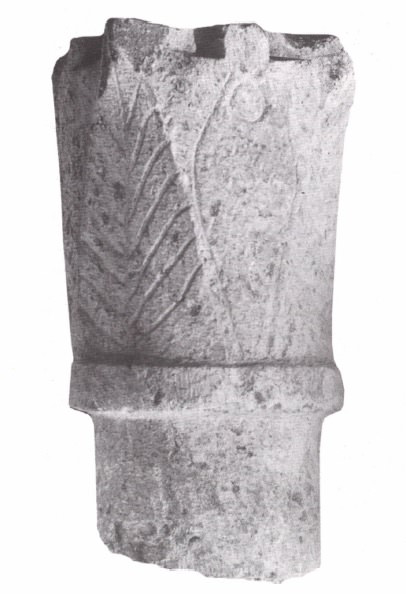
A considerable group of shelves and capital-imposts with bent top acanthus leaves were found; one of these in marble is datable between VI and VII century (fig. 4). To make the capitals, they often used reused materials like the shelf worked from the torso of a classic statue shows and the capital obtained from an Imperial Period architectural element (fig. 5).

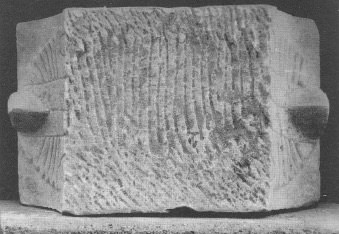
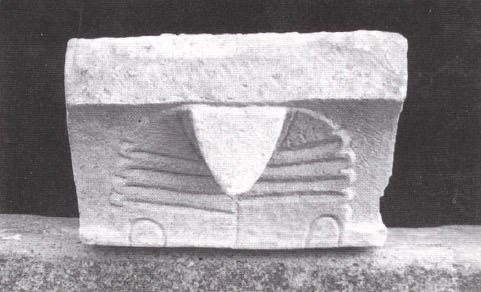
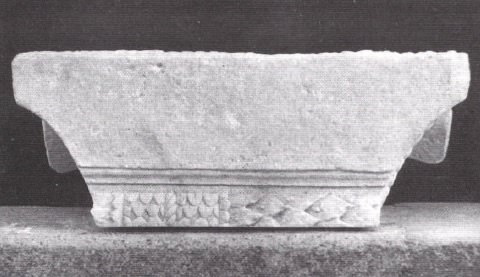
Lastly, a limestone stone(cm 61x28) — now disappeared — from the Columbaris area with a Greek cross and flared arms inscribed with a late antiquity circle (fig. 6).
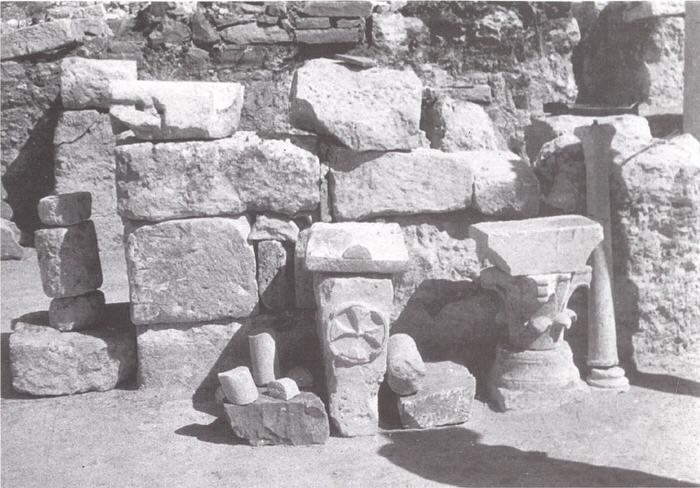
At least for the decorative fragments datable as of the VI century, the assumption is local production by a stonemason's crafts shop active in the crafts district, located in the southern sector of the Cornus complex (fig. 7). The artefacts are currently located in part of the National Archaeological Museum G. A. Sanna of Sassari, and partly in the municipal Antiquarium of Cuglieri.
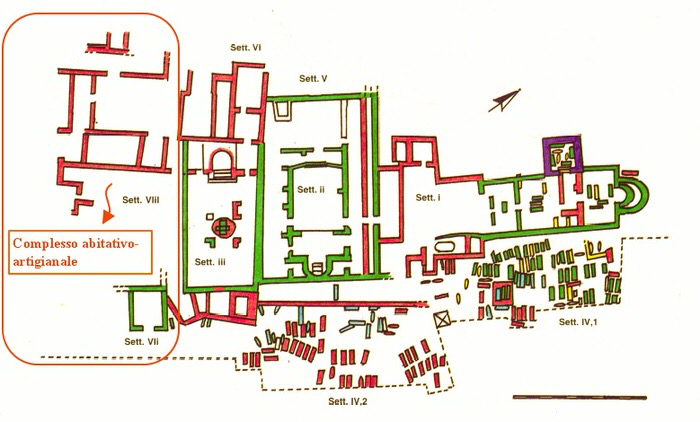
Bibliografia
- C. BARSANTI, L’esportazione di marmi dal Proconneso nelle regioni pontiche durante il VI secolo, in Rivista Nazionale di Archeologia e Storia dell’Arte, s. III, XII, 1989, pp. 91-200.
- R. CAPRARA, Tarda Antichità e Medioevo, in F. LO SCHIAVO (a cura di), Il Museo Sanna in Sassari, Sassari 1986, pp. 169-184.
- R. CORONEO, Architettura romanica dalla metà del Mille al primo '300, Nuoro 1993, pp. 175, 276.
- R. CORONEO, La cultura artistica, in P. CORRIAS, S. COSENTINO (a cura di), Ai confini dell’impero: storia, arte e archeologia della Sardegna bizantina, Cagliari 2002, Cagliari 2002, pp. 99-107.
- R. CORONEO, Capitelli d’importazione orientale in Sardegna fra la metà del V e la metà del VI secolo, in Aristeo. Quaderni del Dipartimento di Scienze Archeologiche e Storico-artistiche dell’Università degli Studi di Cagliari, 1, 2004, pp. 263-280.
- R. CORONEO, Arte in Sardegna dal IV alla metà dell’XI secolo, Cagliari 2011, pp. 82, 195, 197, 215, 224, 266-270.
- L. DE MARIA, Materiali fittili da costruzione, in AA.VV., L'archeologia romana e altomedievale nell'Oristanese. Atti del Convegno di Cuglieri (22-23 giugno 1984) = Mediterraneo tardoantico e medievale, Scavi e ricerche, 3, Taranto 1986, pp. 191-196.
- F. W. DEICHMANN, Corpus der Kapitelle der Kirche von San Marco zu Venedig, Wiesbaden 1981, pp. 41-42, 47, 103-104, 115.
- G. FARRIS, Le aree paleocristiane di Cornus, Oristano 1993, pp. 31-32, 109, 112, 115, 131-136, 141.
- A. M. GIUNTELLA, Cornus I.1. L'area cimiteriale orientale = Mediterraneo tardoantico e medievale. Scavi e ricerche, 13. 1, Oristano 1999, p. 200.
- A. GUIGLIA GUIDOBALDI, Reimpiego di marmi bizantini a Torcello, in A. IACOBINI, E. ZANINI (a cura di), Arte profana e arte sacra a Bisanzio = Milion, studi e ricerche d’arte bizantina, 3, 1995, pp. 603-632.
- G. LILLIU, Per la topografia di Biora (Serri - Nuoro), in Studi Sardi, VII, 1947, pp. 27-104.
- A. MASTINO, Cornus nella storia degli studi con un catalogo delle iscrizioni rinvenute nel territorio del comune di Cuglieri, Cagliari 1984.
- G. NIEDDU, La decorazione architettonica della Sardegna romana, Oristano 1992, p. 87.
- G. NIEDDU, La romanizzazione dell’Oristanese vista attraverso l’analisi delle tipologie architettoniche, in P. G. SPANU, R. ZUCCA (a cura di), Oristano e il suo territorio, 1. Dalla preistoria all’alto Medioevo, Roma 2011, pp. 623-653.
- P. PENSABENE, La decorazione architettonica, l’impiego del marmo e l’importazione di manufatti orientali a Roma, in Italia e in Africa (II-IV d.C.), in A. GIARDINA (a cura di), Società romana e impero tardoantico III. Le merci. Gli insediamenti, Roma-Bari, pp. 285-429.
- D. SALVI, Capitelli di età romana nel Sulcis Iglesiente, in V. SANTONI (a cura di), Carbonia e il Sulcis. Archeologia e territorio, Oristano 1995, pp. 343-355.
- D. SALVI, Cagliari: l’area archeologica di Santa Gilla, in P. CORRIAS, S. COSENTINO (a cura di), Ai confini dell’impero: storia, arte e archeologia della Sardegna bizantina, Cagliari 2002, pp. 231-235.
- R. SERRA, Questioni proposte dalle mensole giustinianee del martyrium cagliaritano di San Saturno, in AA. VV., Sardinia antiqua. Studi in onore di Piero Meloni in occasione del suo settantesimo compleanno, Cagliari 1992, pp. 491-503.
- R. SERRA, Status Quaestionis sul santuario alto medioevale di Sant'Antioco nell'isola omonima (Cagliari), in V. SANTONI (a cura di), Carbonia e il Sulcis. Archeologia e territorio, Oristano 1995, pp. 407-418.
- P. TESTINI, Il complesso paleocristiano di Cornus (Regione Columbaris) in Sardegna, in Actas del VIII Congreso Internacional de Arqueologia Cristiana (Barcelona, 5-11 octubre 1969), Barcellona 1972, pp. 537-561.

 VR
VR